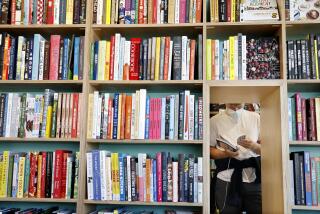‘Sambo’ a Best Seller in Collectibles Booth
- Share via
VENTURA — Past the booths bursting with shiny old silverware and sparkling old cut glass, past the vendor with the cigar tin collection and the guy selling 50-year-old woodworking tools, sits C. M. Lee.
Lee quietly watches over wares that have no shine, no glitter, no particular pedigree.
He sells old books. Not the rare, leather-bound first editions of classics that fetch thousands, either. Just worn and sometimes tattered old editions of odd titles that command $35 or $75, depending upon the oddity of the work.
Lee’s booth is an odd corner indeed of the Antiques & Collectibles Fair, held recently at Seaside Park here. His titles amount to a clever map of our culture, for better and worse, and there is no telling what people will want.
“Little Black Sambo,” the classic of race stereotyping by Helen Bannerman, is propped up at the entrance to Lee’s booth. First editions sell for $4,000; this old copy, from the 1920s, sells for $80. Strangely, Lee reports that any of the many available editions of Sambo, whose namesake Santa Barbara-based restaurant chain went under owing to race backlash, are his current hot sellers. He’s got the book in French--”Histoire du Petit Negre Sambo”--for $95.
“I don’t quite know why,” says the Santa Rosa-based vendor. “Tastes change, I’ve seen that through the years. Right now, Sambo is hot. I had a black woman come in and buy a copy for her child--as a sort of great example of what black people had to struggle with for so long.”
*
People are drawn, Lee makes plain, to the familiar and the ironic.
That’s bookseller talk for those difficult subjects that never go away--only the treatments differ by era. As a result, Lee is given to describing his stock as “outdated literature considered very important at the time” but still intriguing to readers today.
Emerging sexuality is addressed in a 1909 edition of “What a Young Boy Ought to Know,” by the doctor of divinity Sylvanus Stall. Stall’s righteous text would make great fodder for a “Saturday Night Live” skit titled “Pure Thoughts.”
Alcoholism is addressed formally in “The Liquor Problem in All Ages,” by another doctor of divinity, Daniel Dorchester. But it is approached with greater fire in Elton Shaw’s vastly titled “The Curse of Drink, or Stories of Hell’s Commerce--The Liquor Traffic in Its True Light.”
Most distinctive and universal of all, perhaps, is the 1820s book by Marianne Farmingham titled “Home Life; or, How to Make Home Happy”--a book to which Lee has affixed a Post-It label with a revised, somewhat promotional, title: “Happy Home Life Secrets!”
In the foreword, Farmingham is described as “an English lady who has a happy knack of saying good things and giving good advice without becoming dull or wearisome” and whose counsel “is recommended to all members of every Christian household.”
While Farmingham’s genteel insights span many subjects, most telling of all is her thinly veiled assertion that every family must have someone who can act, plainly, as brains of the outfit. In a subject titled “Family Conversation,” she writes: “There is the need of a thoughtful mind in the head of the family, which has power to control the conversation and keep it going within proper bounds and lead it in right directions.”
As crusty and fascistic as that sounds, it’s not an inappropriate recommendation to a culture that once lavished attention upon and belief in black Sambo--for all the wrong reasons. But then insight never has sold easily.
*
Down the aisle from Lee is the fair’s other bookseller, Chatsworth-based Lynn MacLean. The emphasis here is on guidebooks, books on antique prices, and even current editions of offbeat titles.
Her hottest seller? An insight-free but impossible-to-keep-in-stock “The Vanishing American Outhouse,” by Ronald S. Barlow.
MacLean doesn’t know why this is so, save the fact that Barlow has a series of volumes on subjects that seemingly create their own audiences. In stock and selling somewhat behind the outhouse volume is Barlow’s “The Vanishing American Barber Shop: An Illustrated History of Tonsorial Art, 1860-1960.”
What MacLean does know, however, is the same thing Lee talks about: People have a way of coming back to things they once feared or found taboo or didn’t quite understand in the first place.
Sambo was a black boy whose adventures landed him preposterously behind a stack of pancakes, and the outhouse is a strange relic that has always induced embarrassed laughter before anything else. That they should pair up as the show’s top literary subjects seems as fitting as anything else, cocked eyebrow from the ghost of Farmingham notwithstanding.
More to Read
Sign up for our Book Club newsletter
Get the latest news, events and more from the Los Angeles Times Book Club, and help us get L.A. reading and talking.
You may occasionally receive promotional content from the Los Angeles Times.










